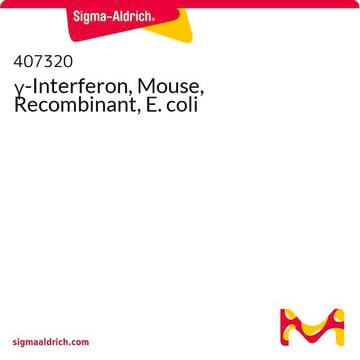407303
γ-Interferon, Mouse, Recombinant, E. coli
Sinônimo(s):
IFNG, Type II IFN
Faça loginpara ver os preços organizacionais e de contrato
About This Item
Código UNSPSC:
12352202
NACRES:
NA.77
Produtos recomendados
Ensaio
≥95% (SDS-PAGE)
Nível de qualidade
forma
liquid
fabricante/nome comercial
Calbiochem®
condição de armazenamento
OK to freeze
avoid repeated freeze/thaw cycles
solubilidade
water: soluble
nº de adesão de ID de proteína
nº de adesão UniProt
Condições de expedição
wet ice
temperatura de armazenamento
−70°C
Informações sobre genes
mouse ... Ifng(15978)
Descrição geral
Note: 1 KU = 1000 units.
Research area: Immunology and Cytokines
Recombinant, mouse γ-interferon, consisting of 134 amino acids, expressed in E. coli as a single, non-glycosylated polypeptide.
Recombinant, mouse γ-interferon, consisting of 134 amino acids, expressed in E. coli as a single, non-glycosylated polypeptide.
Aplicação
γ-Interferon has been used to assess the response of wild-type and cytosolic phospholipase A2 (cPLA2)-deficient cells to IFN-mediated signals. It has also been used to study the signaling pathway associated with IFN-γ and to explore the potential role of β-Arrestin1 in the dephosphorylation of signal transducer and activator of transcription 1 (STAT1).
Ações bioquímicas/fisiológicas
Interferon-gamma (IFN-γ), a proinflammatory cytokine, exhibits a significant impact on innate and adaptive immunity in terms of combatting intracellular infections and facilitating tumor control. It has a significant impact on various immunological pathways. IFN-γ influences the following biological processes:
Antigen Processing and Presentation: IFN-γ enhances the expression of molecules involved in antigen presentation. This helps in the efficient activation of T cells, leading to the initiation of adaptive immunity.
Reactive Oxygen Species (ROS): IFN-γ stimulates the production of ROS by promoting the assembly of NADPH oxidase subunits. These ROS possess strong microbicidal effects, aiding in the defense against invading pathogens.
Autophagy: IFN-γ induces the expression of proteins involved in autophagy, facilitating the clearance of intracellular pathogens and contributing to immune defense.
Apoptosis: IFN-γ triggers apoptotic cell death by increasing the expression of molecules associated with the apoptotic pathway.
Cell Migration and Leukocyte Traffic: IFN-γ promotes the expression of chemokines and adhesion molecules, facilitating immune cell migration and contributing to the initiation of inflammatory responses.
Antiviral Mediators: By inducing the expression of various antiviral proteins, IFN-γ counteracts viral infections at multiple stages of the viral life cycle.
Antigen Processing and Presentation: IFN-γ enhances the expression of molecules involved in antigen presentation. This helps in the efficient activation of T cells, leading to the initiation of adaptive immunity.
Reactive Oxygen Species (ROS): IFN-γ stimulates the production of ROS by promoting the assembly of NADPH oxidase subunits. These ROS possess strong microbicidal effects, aiding in the defense against invading pathogens.
Autophagy: IFN-γ induces the expression of proteins involved in autophagy, facilitating the clearance of intracellular pathogens and contributing to immune defense.
Apoptosis: IFN-γ triggers apoptotic cell death by increasing the expression of molecules associated with the apoptotic pathway.
Cell Migration and Leukocyte Traffic: IFN-γ promotes the expression of chemokines and adhesion molecules, facilitating immune cell migration and contributing to the initiation of inflammatory responses.
Antiviral Mediators: By inducing the expression of various antiviral proteins, IFN-γ counteracts viral infections at multiple stages of the viral life cycle.
Advertência
Toxicity: Standard Handling (A)
forma física
In 10 mM PBS, pH 7.4.
Nota de preparo
Dilute only in buffers containing protein such as 0.1% BSA.
Reconstituição
Following initial thaw, aliquot and freeze (-70°C).
Outras notas
Zantl, N., et al. 1998. Infect. Immun. 66, 2300.
Familletti, P.C., et al. 1981. Methods Enzymol. 78, 387.
Familletti, P.C., et al. 1981. Methods Enzymol. 78, 387.
Informações legais
CALBIOCHEM is a registered trademark of Merck KGaA, Darmstadt, Germany
Código de classe de armazenamento
12 - Non Combustible Liquids
Classe de risco de água (WGK)
WGK 2
Ponto de fulgor (°F)
Not applicable
Ponto de fulgor (°C)
Not applicable
Certificados de análise (COA)
Busque Certificados de análise (COA) digitando o Número do Lote do produto. Os números de lote e remessa podem ser encontrados no rótulo de um produto após a palavra “Lot” ou “Batch”.
Já possui este produto?
Encontre a documentação dos produtos que você adquiriu recentemente na biblioteca de documentos.
cPLA2 regulates the expression of type I interferons and intracellular immunity to Chlamydia trachomatis
Vignola MJ, et al.
The Journal of Biological Chemistry, 285(28), 1625-1635 (2010)
Interferon-gamma (IFN-?): Exploring its implications in infectious diseases
Kak G, et al.
Biomolecular Concepts, 64-79, 9(1)-9(1) (2018)
Pei-Ju Liu et al.
Journal of the American Society of Nephrology : JASN, 33(11), 1989-2007 (2022-11-01)
Myo1e is a nonmuscle motor protein enriched in podocytes. Mutations in <i>MYO1E</i> are associated with steroid-resistant nephrotic syndrome (SRNS). Most of the <i>MYO1E</i> variants identified by genomic sequencing have not been functionally characterized. Here, we set out to analyze two
Impact of interferon-? on hematopoiesis
Bruin AMD, et al.
Blood, 24(16), 2479-2486 (2014)
Christin Pelzel et al.
Molecular cell, 50(1), 149-156 (2013-04-16)
Signal transducer and activator of transcription 1 (STAT1) is activated by tyrosine phosphorylation upon interferon-γ (IFNγ) stimulation, which results in the expression of genes with antiproliferative and immunomodulatory functions. The inactivation of STAT1 occurs through tyrosine dephosphorylation by the tyrosine
Nossa equipe de cientistas tem experiência em todas as áreas de pesquisa, incluindo Life Sciences, ciência de materiais, síntese química, cromatografia, química analítica e muitas outras.
Entre em contato com a assistência técnica






